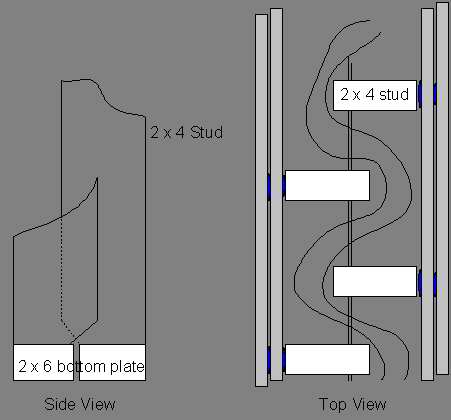Introduction
Using the mass principle, sheetrock is excellent. For outside surfaces, brick, stone or stucco work very well. Wall thickness: the thicker the better, because there is more air space. See a later section to understand what to fill the air space with.
Applying Sheetrock
Get a lot of silicone caulking. It is not expensive, so get more than you think you will need.
Apply a thick bead of the caulk to all stud surfaces before you apply the sheetrock (see the blue in the drawings). Then attach the sheetrock with screws or nails. Screws are actually better, because you can use fewer holes.
Now, follow the same procedure and apply a second sheet of sheetrock. The silicone acts as a dampener and retards vibration transfer. It does an excellent job for the bucks spent. This second layer of sheetrock will usually be all you will need to apply if you already have one layer of sheetrock up in the room.

There are some new alternatives to using silicone caulking, however, using the silicone as described is the cheapest way to soundproof a wall.
Dampening has come a long way recently and new products have been developed that offer good alternatives to silicone which work better. These new products have visco-elastic materials (fancy word for sticky and stretchy), which are used as layers between two stiff materials, and do wonderful jobs in stopping noise.
One company offers already sandwiched materials using a good visco-elastic product. It works well, but is expensive, because they have to assemble it and then ship heavy stuff across the country, etc.
A newer and better material exists which is called Green Glue. It allows you to apply the visco-elastic material yourself (easily and it is actually hard to do wrong). It is applied like the silicone in the space between the two sheets of sheetrock. It costs $0.50 to $1.00 per square foot of wall space, so it is affordable for most projects. Details and links available on the Links page.
Soundproofing and New Wall Construction
New wall construction can really give you the freedom to stop noise from entering. See the diagram for how to build a new wall. Alternating studs and splitting the 2x6 bottom and top plate can really work well. The diagram assumes there is sheetrock on both sides (interior wall), but the same principle works with stucco, siding, brick etc., for the outside.
Use a 2x6 bottom and top plate as shown. Cutting the 2x6 in half stops the direct transfer through the wood. Notching where it meets the 2x4 wall studs also disconnects the direct transfer. Insulate per diagram or later discussions here. This will create a nice soundproofing barrier that will stop the noise.

Continue to Ceiling Soundproofing.
